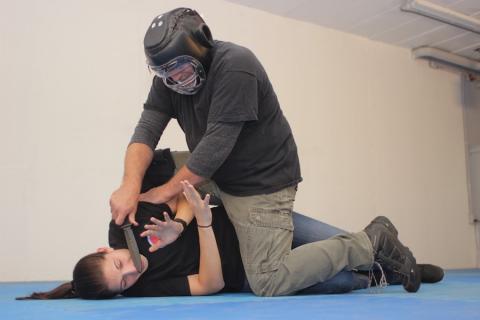The Fight
January 18, 2021
Fights are not static. Things move. People move. Bear-hugs and headlocks and all that stuff happen sometimes in a fight, but they are transitional actions. You do not get bear-hugged just to be held (except by bouncers). A Threat wraps his big arms around you from behind either to pick you up and shake you (disorienting and intended as an intimidating show of strength) or to drive you into a wall. Maybe to throw you over a balcony. If you practice technique-based defense, will they work if the Threat refuses to stand there? If he is using that headlock to slam you from wall to wall?
The Lowest Level of Force
December 7, 2020
The Records area at Rusafa Prison Complex in Baghdad is enclosed by a chain-link fence and was almost always crowded. It’s a stressful place, with inmates being processed in and out, Iraqi military, police, corrections, advocates, politicos, and sometimes families of the convicts are present and a small handful of American advisors.
Karate: Is There Equipment That Can Help Me?
July 23, 2018
Much of modern karate training can be done simply by refining one's technique through careful internal reflection. The only thing required is a karate uniform or do-gi. However, there can be great benefit to using equipment in training. The use of equipment can be vital for developing a method of direct feedback regarding the execution and delivery of power into a target. To this end, equipment can be used for two primary purposes: (1) understanding the internal feeling of the body as a technique impacts an object, and (2) developing focus and power delivery through correct alignment to a target outside the body.
Keri: Kicking Techniques
April 10, 2017
One difference between martial arts styles developed in Asia and many of the Western arts is the refinement of the legs and feet as striking weapons. In Shotokan karate in particular, kicking techniques, or keri are seamlessly integrated into the curriculum and are one of the six major classes of techniques (zuki, uke, uchi, nage, keri, and dachi).
Four Fundamental Requirements of Martial Arts
March 20, 2017
Karate-do, or any other martial art, is, at its core quite simple. However, it can be made far more complex than what it actually is. The multitude of techniques, combinations, kata, and partner drills—combined with nebulous concepts like "use your hips," "lower your stance," "do budo karate," "make more kime," and "use your ki"—can make martial arts seem overwhelming.
Counter Assault: Surviving Attacks
-
September 12, 2011
Talking to a friend in a public place, her eyes suddenly focused over my shoulder and went wide. I turned fast, elbow up, spinning and drop-stepping towards the Threat. Didn’t feel the solid contact of a head, but felt an arm brush away and continued.
Counter Assault: Attack from the Front
-
September 5, 2011
When a threat attacks you, he has a plan and his is counting on your surprise. He is expecting you to freeze in fear and leave him free to do whatever dastardly things he has planned. He expects your own adrenaline to ensure that he wins. An operant conditioned response will kick in before the adrenaline surge that might trigger freeze rather than fight or flight.
Facing Violence: The Unconscious Stuff-Finding Your Glitches
-
August 1, 2011
In my own experience, almost everyone hesitates before doing a dangerous or uncomfortable thing. Whether jumping out of an airplane or diving into cold water or singing karaoke in public, very few people can just go for it without hesitation the first time.
More About Violence Dynamics
-
May 23, 2011
Social violence can roughly be delineated as the Monkey Dance (MD), the Group Monkey Dance (GMD), the Educational Beat-Down (EBD) and the Status-Seeking Show (SSS). The MD and GMD were discussed in <a href="/articles/violence-dynamics">part one</a> of this article. We will continue starting with the Educational Beat-Down.
Violence Dynamics
-
May 16, 2011
Bill and I were talking to the warden in an Iraqi prison, drinking chai. A gun fired. Other than ours and the warden’s bodyguards there shouldn’t have been loaded weapons in that section of the building. I put down my tea, stood and drew my sidearm. I started clearing the building.
Self-defense: Down and Dirty
-
May 9, 2011
Let's start with one, very simple thing—power generation. A traditional martial artist is taught how to hit hard. Different systems have different methods of power generation, but two of the most common involve a solid connection with the ground and good structure.
The Seven Aspects of Self-defense
-
January 13, 2010
The following article is an excerpt from an upcoming book by Rory Miller, tentatively titled 7. It will explore the seven aspects that are critical to self defense, giving you a few hints on staying alive, or if you teach self-defense, some critical information you can pass along to your students.
Meditations on Violence
-
May 22, 2008
People are weird. They have an almost infinite ability to learn and communicate. At the same time, this amazing ability is used as much for fantasy and entertainment as it is for information and survival. Take, for example, the rhinoceros and the unicorn.












